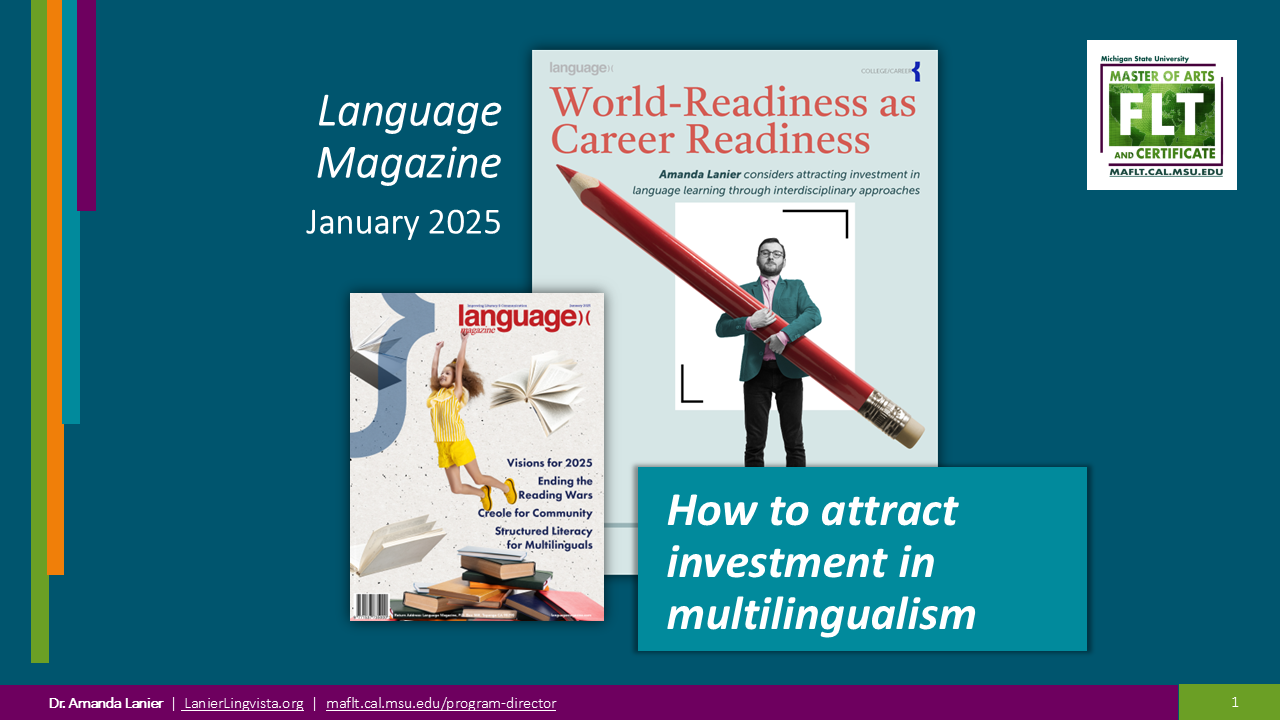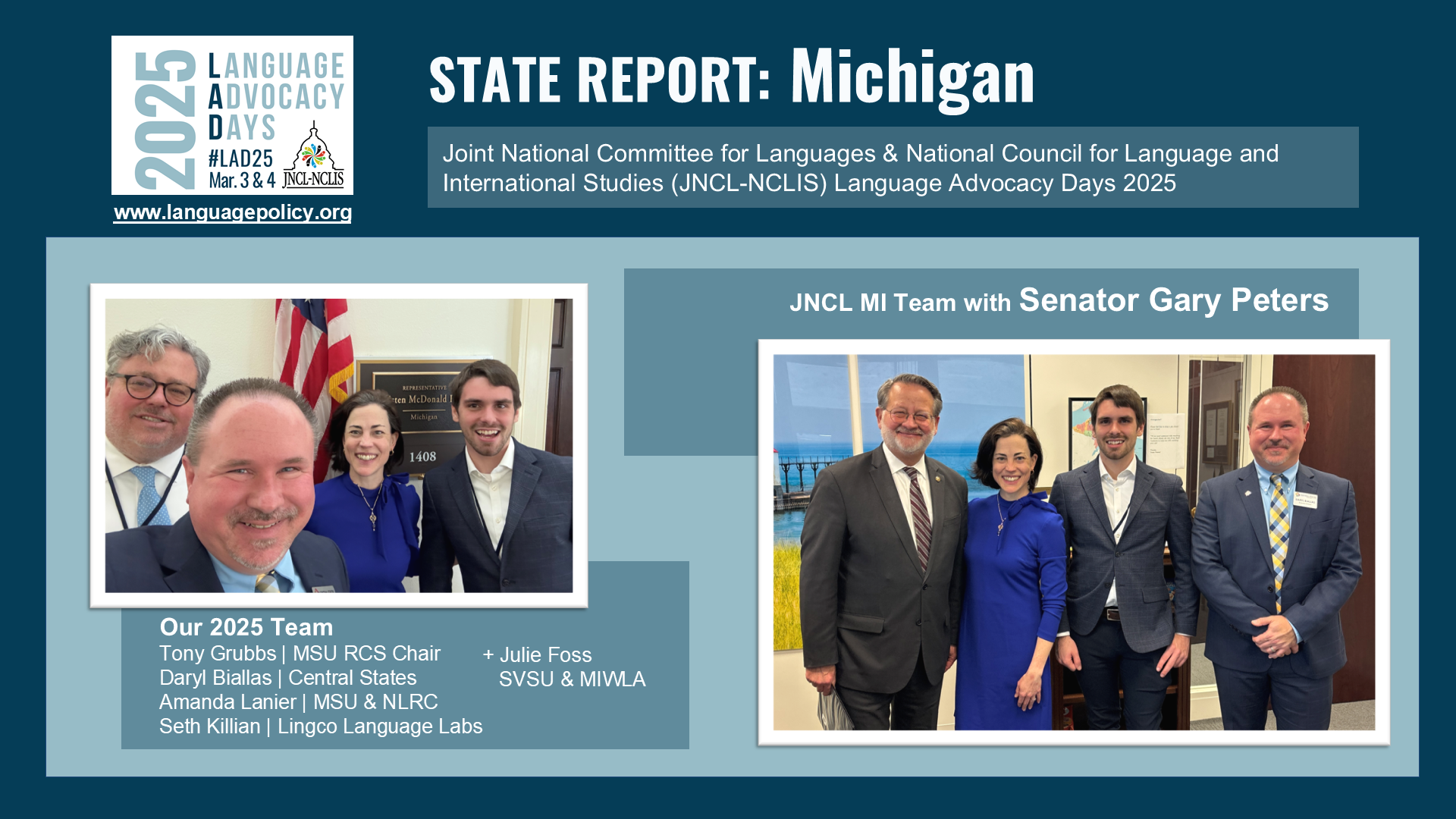Attracting Investment in Language Education through Interdisciplinary Approaches
Language Magazine – January 2025
https://languagemagazine.com/2025/02/13/world-readiness-as-career-readiness/
Is the end of language education in sight?
Absolutely not, even if your favorite AI can translate and even deepfake fluent speaking (Matsakis, 2024).
But world language enrollments are declining, and technology is advancing faster than we can imagine.
How can we keep attracting investment in language learning and teaching?
“Here is the problem: We are very good at making arguments about the value of language learning that appeal to others who think just like us… We want to believe that our passion is contagious, as long as our energy holds out. If we are very fortunate and convincing, a few of the 7% of students who are studying languages will have the audacity to follow us down the paths we have chosen, into degrees in language, literature, linguistics, or language teaching.
“We are also remarkably bad at framing arguments that align with the priorities of people who do not value multilingualism like we do. Language learning ought to enhance our perspective shifting skills more than that! Our language learners, their parents, teachers in other subject areas, administrators and supervisors, policy makers, and others may appreciate our enthusiasm but nevertheless choose to allocate their limited resources to other priorities…”
Full Article
Read more below:
Related Resources
Advocacy for Language Education – Organizations and Resource Lists
JNCL-NCLIS
https://www.languagepolicy.org/advocacy-resources
ACTFL > Advocacy
https://www.actfl.org/advocacy
Language Connects Foundation > Advocacy
https://www.languageconnectsfoundation.org/programs-initiatives/public-education/advocacy
Modern Language Association > Advocacy
https://www.mla.org/Resources/Advocacy
Credentials and Assessment
Seal of Biliteracy
https://sealofbiliteracy.org
The Global Seal of Biliteracy
https://theglobalseal.com/
Language Testing International
https://www.languagetesting.com/
Avant Assessment
https://www.avantassessment.com/tests
World-Readiness and Global Competence
ACTFL Educator Resources > Summary of World-Readiness Standards for Learning Languages
https://www.actfl.org/educator-resources/world-readiness-standards-for-learning-languages/standards-summary
Asia Society > Global Competence
https://asiasociety.org/mapping-nation/global-competence
United Nations Sustainable Development Goals
https://sdgs.un.org/goals
Career Readiness, Employment, and Labor Market Trends
NACE: What is Career Readiness?
https://www.naceweb.org/career-readiness/competencies/career-readiness-defined
Language Connects Foundation > Free Resources, e.g., Language & Careers https://www.languageconnectsfoundation.org/connect-with-language
Global Seal of Biliteracy > Language Certification in the Workplace
https://theglobalseal.com/language-credentials-careers
Language Testing International Blog > Bilingual Professionals https://www.languagetesting.com/blog/category/bilingual-professionals/
Deloitte Insights > Higher Education
https://www2.deloitte.com/us/en/insights/focus/reimagining-higher-education.html
U.S. Army Human Resources Command > Foreign Language Proficiency Bonus
https://www.hrc.army.mil/content/Foreign%20Language%20Proficiency%20Bonus
National and International Data and Comparisons
Organisation for Economic Co-Operation and Development (OECD) > Key Indicators
https://www.oecd.org/en/data/indicators.html
OECD Education GPS
https://gpseducation.oecd.org/
Programme for International Student Assessment (PISA) https://www.oecd.org/en/about/programmes/pisa.html
Modern Language Association > MLA Language Map
https://www.mla.org/Resources/Guidelines-and-Data/MLA-Language-Map
Strategic Language List
https://www.dlnseo.mil/Oversight/Readiness
Technology – Generative AI and Language Learning Apps
Wakelet @LanierLingvista > AI Tools for Language Learning https://wakelet.com/wake/e_Aaa64IbgGTqqAvlmERF
Avant Assessment > Mira
https://www.avantassessment.com/mira
Extempore > Ask Tempo https://help.extemporeapp.com/en/articles/10099736-using-extempore-s-task-assistant-ask-tempo
Claude.ai by Anthropic
https://www.anthropic.com/claude






